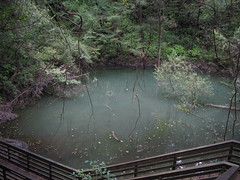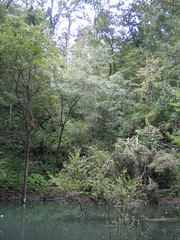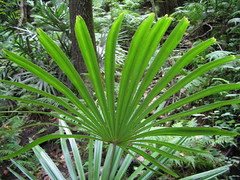This afternoon I roadtripped north to Gainesville, to visit Devil's Millhopper Geological State Park, which is basically a very large sinkhole.
After an uneventful trip to the park, I was shocked to find the park immediately next to a housing development (!). I'm no geologist, and I'm sure various experts came in to do all kinds of rock studies, but it seems to me that building a housing development right next to a large sinkhole isn't perhaps the wisest thing to do. Check out this map - the streets that border the park are lined with homes!!
Anyway, I walked in and found my way to the millhopper, which was quite large as far as sinkholes go: 500 feet across, and 120 feet deep. I walked down the stairs to the observation deck and looked around. It sounded like it was pouring rain, from all the little waterfalls that led to the basin.
A large sinkhole that became a state geological park.
I was about to leave but decided to walk around the nature trail. After all, time to work on my fear of getting attacked by snakes and alligators. ;) The trail was only a half-mile long, so soon I was back at the ranger station. I jokingly asked the ranger if that was the lowest point in the state, and he replied in all seriousness that it definitely wasn't. See, we were on the "Sumter Ridge" which apparently soars 175 feet above sea level, leaving the bottom of the Millhopper at an elevation of 50 feet. Well, that's good to know.
Looking up to the sky from the bottom of Devil's Millhopper.
Inside the sinkhole were various plants, such as this one, a Needle Palm. The sign said these plants only grow in ravines or sinkholes in the northern part of the state, where they are protected from freezing temperatures. Um... freezing temperatures... Florida... I can't quite wrap my mind around that.



No comments:
Post a Comment